How To Make African Violets Bloom (And Keep Them Blooming)
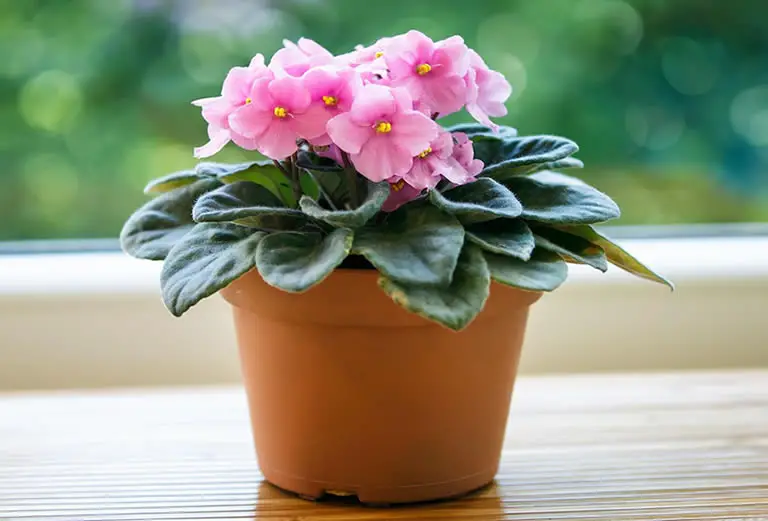
In this article I cover the subject of african violet blooms to help you better understand how and when this beautiful plant produces flowers and what to do if your plant refuses to bloom.
Table of Contents
- African violet blooms – a quick background
- How many times african violets bloom throughout the year
- When african violets bloom as an indoor plant
- Why your african violet is not blooming & what to do about it
- How to get african violets to bloom
- How long it takes an african violet to rebloom after blooming stops
African violet blooms – a quick background
African violets are flowering plants that resemble succulents but are not.
They grow in the mountainous tropical regions of Africa with high humidity levels and warm temperatures.
There are 10 varieties of african violets that are mostly grown in the US as houseplants.
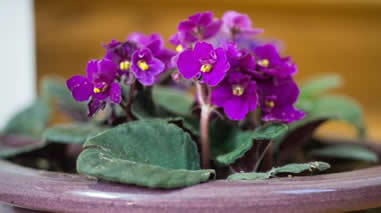
The natural habitat of the african violet plant, scientific name Saintpaulia, is warm and humid as they grow in the cloud forest areas of Africa being found in Tanzania, southeastern Kenya and the tropical parts of east Africa.
Unfortunately, some species and subspecies of african violets are now endangered as more and more of their native habitat is cleared for agricultural purposes.
As houseplants african violets are easy-care plants that grow quite happily in the average home because households are, throughout the year, kept at fairly consistent temperatures that are friendly to this tropical plant.
How many times african violets bloom throughout the year
African violets are perennials. A perennial is a plant that continues to live after it has finished blooming.
It reblooms every year.
If you have perennials in your home or garden then you will notice that they usually bloom at least once per year.
So, does this mean you can expect one flowering every year from your african violet?
African violets can bloom continuously throughout the year.
Flowers can live for up to 3 weeks and as they die new flowers emerge to take their place. This can produce a year-round bloom.
A typical african violet will bloom 10 – 12 months of the year.
Although african violets are perennials this does not mean the plant is only limited to a once-yearly bloom.
African violets are unique in the fact that they can produce flowers continually throughout the entire year.
If you follow a good care routine for your african violets (see our african violets leaves care guide) you can expect to see flowers on your plant for at least 10 months every year.
It is not unusual for potted african violets, grown as houseplants, to bloom continuously and produce flowers all-year-round.
When african violets bloom as an indoor plant
When can you expect your african violets to bloom and produce flowers?
Mature african violets bloom continually.
When an african violet plant first blooms it should continue to bloom.
The average african violet will bloom between 10 to 12 months of the year.
This means you will have a plant that is continually producing flowers.
A newly propagated plant will first bloom after about 9 months.
An african violet flower will typically live for about three weeks.
But the great thing about these easy-care plants is that they do not normally stop blooming.
A healthy african violet plant will continue to flower throughout the year.
This is especially true of african violet houseplants.
As most homes are kept at a consistent and comfortable temperature for african violets this means the plants have the ideal conditions to continue producing flowers all year long.
This is one reason these beautiful little plants are so popular across the USA, Canada, Australia and the UK as indoor décor.
Why your african violet is not blooming & what to do about it
Now we get the problem of non-blooming african violets.
I often get asked the question “why aren’t my african violets blooming?” and there is no one-size-fits-all answer unfortunately.
However, there are key things that are likely to be the cause.
As I outline them below you must determine which one is the most likely reason behind your plant’s inability to produce flowers.
Here are the most common reasons for a non-blooming african violet plant:
- Lack of light.
- Incorrect growing medium – wrong soil used.
- Lack of nutrients in the soil.
- Poor watering routine. Underwatering or overwatering.
- Incorrect conditions such as low humidity and lack of warmth.
- Plant may be severely root bound and needs repotting.
I will now cover the steps you need to take to address each of the above problems but bear in mind that it is highly unlikely your plant will be suffering from all the above problems.
If it were the case that your plant was not blooming because it was suffering from multiple causes then you would likely have much more serious problems than just a lack of flowers.
There would be other symptoms such as drooping leaves and a dying plant.
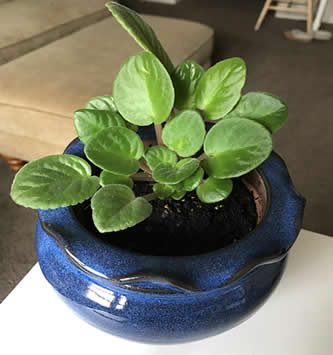
As long as your plant looks healthy then you will find that one of the aforementioned problems is likely to be the cause.
It’s just a matter of identifying that cause and then taking the simple actions steps I lay out below to kick-start the plant into bloom.
If you cannot immediately identify the problem then take each action step one at a time, until you identify the problem is.
If, after examining the plant and its soil and checking its local environment for warmth and humidity, you still cannot tell what the problem is take each action step in turn.
Then give the plant time to respond with new growth, before looking for other explanations.
How to get african violets to bloom
Below are the steps you need to take to get african violets to bloom.
I have covered each of the points mentioned above that are potential causes for non-blooming african violets and given the fixes for those problems.
Give the plant more light
By far the most common reason for an african violet not blooming is a lack of light.
Although african violets should never be given direct sunlight, as it will burn the leaves and cause other problems, they still need plenty of indirect sunlight in order to produce flowers.
Unfortunately, because houseplant owners are told to keep their african violets away from direct sunlight many think it is okay to place their plant in a dark corner of their home.
African violets will be content in fairly dim light but they will never thrive in it and will seldom, if ever, produce flowers.
You must ensure your african violet gets plenty of good idirect light.
Of course the plant should never be placed near a window or open area that gets strong direct sunlight but it should be placed in a well-lit area that gets plenty of natural light.
As I pointed out in the article about african violets light requirements you can help your plant out greatly by using a small inexpensive grow light that sits directly above the plant.
This will eliminate the potential for a lack of light and ensure your plant blooms year-round (as long as there is not another problem causing the lack of blooms).
Use the correct soil
Ensure that your african violet is in the correct type of soil.
Many houseplant owners will use the same houseplant potting mix for all their indoor plants.
A normal houseplant potting soil will usually suffice for most houseplants but this is not the case with african violets.
For african violets you need a specific type of soil. Some houseplant owners will use a succulent soil because they mistakenly think african violets are succulents.
African violets require a specific type of soil to thrive.
Soil that is slightly more acidic than normal houseplant potting mix is best for african violets and gives the plant the best chance for healthy year-round blooms.
I cover the subject of african violets soil here and that article gives all the information you need for ensuring your plant is growing in the correct type of medium.
Through trial and error I have found that miracle gro african violet potting mix works best. Having said that though, any type of soil you can get locally that has been specifically formulated for african violets will work just as well.
Give the plant nutrients
Even when you are using the correct soil your plant may not be getting enough nutrients.
If your soil is fresh then you will not need to add fertilizer.
However, if you have not fed the plant in some time, or been using the same soil for over 6 months, then it is a good idea to use a fertilizer that contains nutrients and humic and fulvic acids.
These acids will ensure the correct soil pH value. Be aware that a standard fertilizer will not contain these necessary acids.
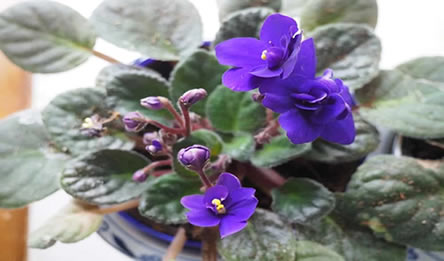
My fertilizer of choice is African Violet Focus but unfortunately it is difficult to get in the US.
So, when I can’t get hold of my first choice my next best choice is Miracle-Gro Blooming Houseplant Food that is formulated to give african violets everything they need.
Be sure you water the plant correctly
The correct watering routine is vitally important to african violets – more so than most other houseplants.
A lack of water will prevent an african violet from blooming.
However you must be very careful with your watering routine as overwatering the plant can cause the same effect and actually do very serious damage to the plant.
There is a lot of misconceptions about how much water african violets need.
This is partly due to the fact that you can propagate african violets in water (though I don’t advise it).
One of the most common problems I come across with sickly african violets is overwatering.
Overwatering an african violet actually leads to dehydration in the plant – see my guide to african violet watering for the correct water care of your plant.
As a rule-of-thumb allow the soil to dry out before watering an african violet.
As soon as the top layer is dry, it’s time to water your plant.
Humidity levels should be regulated
African violets are tropical plants that grow in the cloudy tropical regions of Africa.
They like humidity.
As I pointed out in the article, African Violets. Guide For Humidity Levels & Conditions, most homes do not have high enough humidity levels to keep african violets comfortable.
It is therefore best to take some simple action steps to help raise the humidity levels directly around the plant.
You can do this by using self-watering plant pot or by simply placing your african violet pot onto a saucer or tray that is filled with pebbles and a little water.
For more detailed information read the article linked to above.
Also ensure the plant is in a warm environment.
Although african violets grow in temperatures up to 80°F in their native habitat most household temperatures are sufficient for healthy growth and blooms.
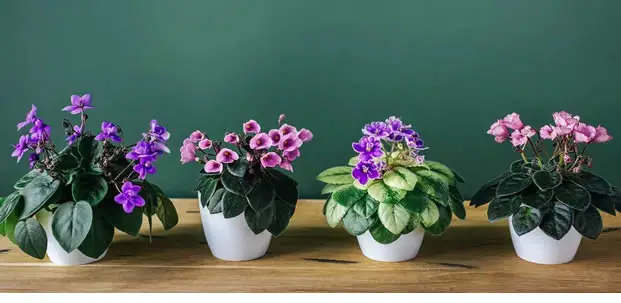
Just be sure the plant does not experience extreme temperatures and sudden temperature drops or increases.
The ideal daytime temperature for african violets is about 70°F with an ideal upper limit of 80°F.
As most households in the US have temperatures that range between 68°F and 76°F your african violet should be just fine as far as the temperature goes.
Consider repotting the plant
African violets do not like to be root bound.
Although they will tolerate lack of room for root growth for a short period it is best to repot your plant at least once per year to avoid this happening.
You should even consider dividing an african violet if it is growing quite large.
How long it takes an african violet to rebloom after blooming stops
So you have taken action to force your african violet plant to rebloom after it stopped flowering. How long will it take before the plant flowers again?
African violets bloom continuously throughout the year.
If you had problems with the plant and had to force it to bloom then it will take a few weeks before you see the first sign of new flowers.
As long as you continue a good care routine your african violet will then continue to produce flowers throughout the year.
Do not immediately panic if your african violet stops producing flowers.
Although most african violet houseplants will flower all year-round it is not unusual for a plant to stop blooming for a short period.
Only if your african violet has not bloomed in over 2 months should you take action to force the plant to bloom.
If the plant has stopped blooming completely and you take the action steps outlined above to force it to rebloom then you can expect to see signs of new flower growth after a few weeks.
When propagating a new plant, either from a cutting, leaf or after dividing the plant, it can take up to 9 months before the new plant starts to bloom.
Divided plants tend to bloom much quicker than newly propagated plants.
If your home includes curious pets and children then you may also be interested in learning if african violets are poisonous.
Thanks for reading! I'm Michael — houseplant fanatic and your Pinterest plant guide.
Follow me on Pinterest for fresh updates 🌿



